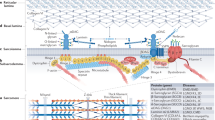Summary
Congenic mice of the MRL +/+ substrain provide an animal model for study of tubular aggregates in skeletal muscle. Tubular aggregates appear limited only to males of the MRL +/+ strain and are not found in other strains, including MRL +/−, MRL lpr/lpr, BXSB/MpJ, BALB/c, SJL/J, AJ, or C3H HEJ. This strain-specific occurrence, and the gradually increasing abundance of tubular aggregates after 6 months of age until virtually all type II myofibers are affected by 2 years, implies that both genetic and developmental factors are necessary for the occurrence of tubular aggregates. These two factors are not sufficient, however, since hormonal alteration by male castration nearly completely prevents the expression of tubular aggregates. Parallels are drawn with how expression of tubular aggregates is limited largely to males in diverse acquired and hereditary human neuromuscular disorders.
Similar content being viewed by others
References
Alexander EL, Murphy ED, Roths JB, Alexander GE (1983) Congenic autoimmune murine models of central nervous system disease in connective tissue disorders. Ann Neurol 14:242–248
Bergman RA, Afifi AK, Dunkle LM, Richard JJ (1970) Muscle pathology in hypokalemic periodic paralysis with hyperthyroidism. II. A light and electron microscopic study. Johns Hopkins Med J 126:100–118
Bernard PA, Max S (1986) Neural control of muscle androgen receptors. Neurochemistry 46:1942–1946
Craig ID, Allen IV (1980) Tubular aggregates in murine dystrophy heterozygotes. Muscle Nerve 3:134–140
Jung I, Baulieu EE (1972) Testosterone cytosol receptors in the rat levator ani muscle. Nat New Biol 237:24–26
Karpati G, Hilton-Jones D, Prescott S, Carpenter S (1987) Castration reduces the rate of denervation atrophy of skeletal muscle fibers in rat solei and plantares. Ann Neurol 22:169 [abstract]
Kreig M (1976) Characterization of the androgen receptor in the skeletal muscle of the rat. Steroids 28:261–274
Miller FW, Dalakas MC (1986) Abundant tubular aggregates (TA) in skeletal muscle of different strains of autoimmune mice. Neurology 36:239 [abstract]
Murphy ED (1981) Lymphoproliferation (lpr) and other single-locus models for murine lupus. In: Merchant B (ed) Immunologic defects in laboratory animals, vol 2. Plenum, New York, pp 143–173
Odor DL, Patel AN, Pearce LA (1967) Familial hypokalemic periodic paralysis with permanent myopathy: a clinical and ultrastructural study. J Neuropathol Exp Neurol 26:98–114
Pierobon-Bormioli S, Armani M, Ringel SP, Angelini C, Vergani L, Betto R, Salviati G (1985) Familial neuromuscular disease with tubular aggregates. Muscle Nerve 8:291–298
Rosenberg NL, Neville HE, Ringel SP (1985) Tubular aggregates; their association with neuromuscular diseases, including the syndrome of myalgias/cramps. Arch Neurol 42:973–976
Salviati G, Pierobon-Bormioli S, Betto R, Damiani E, Angelini C, Ringel S, Salvatori S, Margreth A (1985) Tubular aggregates: sarcoplasmic reticulum origin, calcium storage ability, and functional complications. Muscle Nerve 8:299–306
Schröder JM, Becker PE (1972) Anomalien des T-Systems und des sarkoplasmatischen Reticulums bei der Myotonie, Paramyotonie und Adynamie. Virchows Arch [A] 357: 319–344
Sipila I, Simell O, Rapola J, Sainio K, Tuuteri L (1979) Gyrate atrophy of the choroid and retina with hyperornithinemia: tubular aggregates and type II fiber atrophy in muscle. Neurology 29:996–1005
Szasz G, Gruber W, Bernt E (1976) Creatine kinase in serum. 1. Determination of optimum reaction conditions. Clin Chem 22:650–656
Thibert P (1986) Androgen sensitivity of skeletal muscle: nondependence on the motor nerve in the frog forearm. Exp Neurol 91:559–570
Valle D, Kaiser-Kupfer MI, Del Valle LA (1977) Gyrate atrophy of the choroid and retina: deficiency of ornithine aminotransferase in transformed lymphocytes. Proc Natl Acad Sci USA 74:5159–5161
Wainman P, Shipounoff GC (1941) The effects of castration and testosterone propionate on the striated perineal musculature in the rat. Endocrinology 29:975–978
Author information
Authors and Affiliations
Additional information
Supported in part by NIH grants 5-K07-NS-00734 and 1-R01-NS23719, and by the Jay Slotkin Fund for Neuromuscular Research. Dr. Kuncl is the recipient of a Teacher Investigator Development Award from the NINCDS.
Rights and permissions
About this article
Cite this article
Kuncl, R.W., Pestronk, A., Lane, J. et al. The MRL +/+ mouse: a new model of tubular aggregates which are gender- and age-related. Acta Neuropathol 78, 615–620 (1989). https://doi.org/10.1007/BF00691288
Received:
Revised:
Accepted:
Issue Date:
DOI: https://doi.org/10.1007/BF00691288




